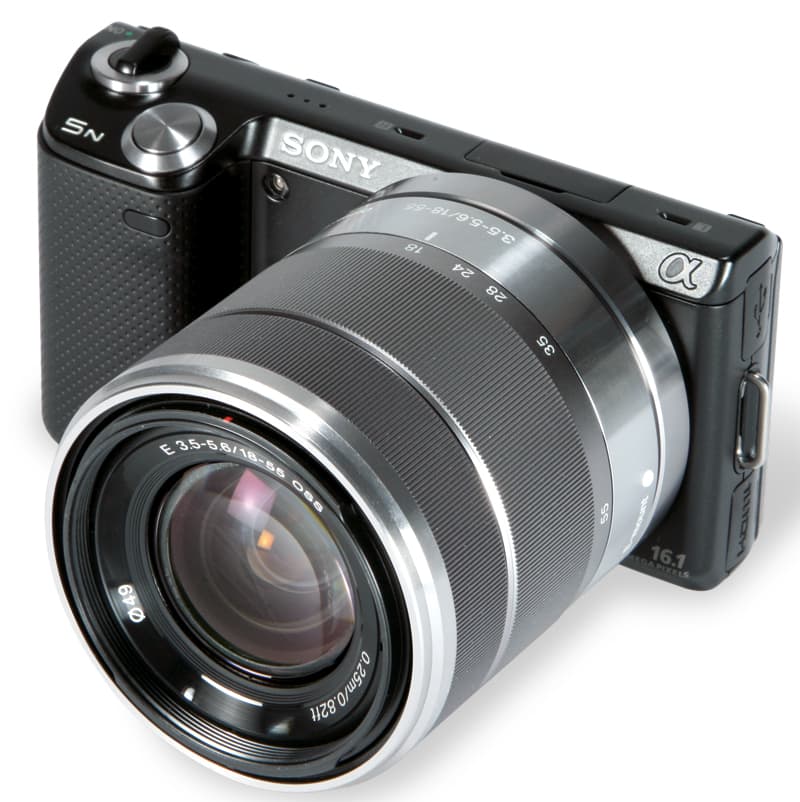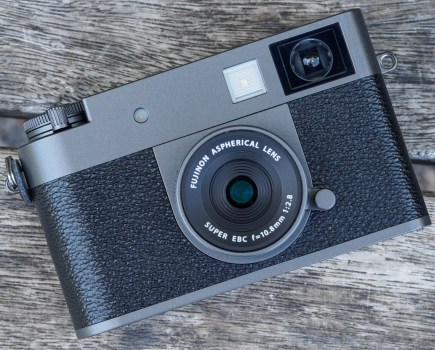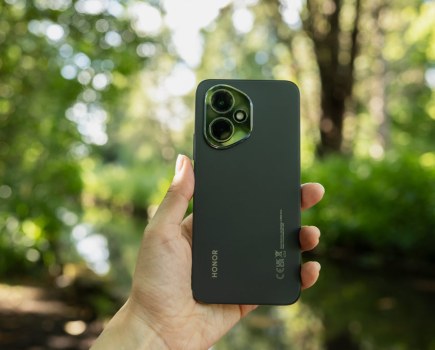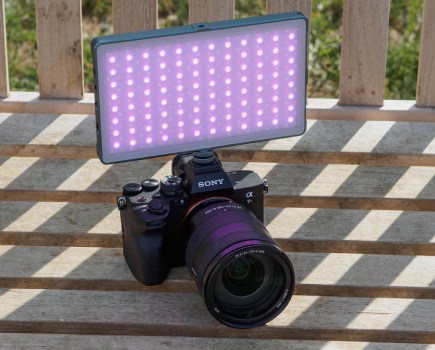Sony NEX-5N at a glance
- 16.1 million effective pixels
- APS-C-sized sensor
- Up to 10fps shooting rate
- 3in touchscreen
- ISO 100-25,600
- Street price approximately £450 (body only)
When Sony updated the NEX-3 with the 16.2-million-pixel NEX-C3 in June, it was a case of ‘when’ rather than ‘if’ the 14.2-million-pixel NEX-5 would receive a similar update. And it came just two months later, in August, when the 16.1-million-pixel NEX-5N was announced, adding a range of new features to the original NEX-5 that had been released just over a year before.
Features
Like the NEX-C3, the NEX-5N uses Sony’s IMX071 CMOS sensor. This sensor has already been discussed in some depth previously, particularly in regard to its use in the Nikon D7000 (see AP 30 April). The sensor is highly regarded, producing very low noise levels, especially when it comes to recovering details in shadow areas.
When we originally tested the Sony NEX-5 (AP 5 June 2010), we were impressed with its features and image quality, but felt a little let down by its handling. However, there is one new feature on the NEX-5N that may go some way to improving its handling compared to the original camera.
With so few buttons on the Sony NEX-5, it was quite time consuming changing the most basic of features. Sony quickly released an updated firmware that enabled nearly all the camera’s rear buttons to be customised for certain functions.
Although this improved the handling of the camera, the NEX-5 was still crying out for one thing – a touch-sensitive screen. Clearly, Sony is either on the same wavelength or at least has listened to feedback from users, as the NEX-5N now comes equipped witha touch-sensitive screen. Apart from these major changes, there are a few other upgrades worth noting. These include a boost in the maximum shooting rate from 7fps to 10fps, and an increase in the sensor’s sensitivity range to ISO 100-25,600 compared to ISO 200-12,800 on the NEX-5.
There is also an optional electronic viewfinder (EVF) in the form of the 2.3-million-dot FDA-EV1S XGA OLED unit, which has the same specification as the EVF used in the Sony NEX-7 and the Alpha 77. The EVF plugs into the accessory port on the top of the camera where the optional flash would usually sit.
There is also a new LA-EA2 lens adapter that, unlike the standard LA-EA1, has the same translucent mirror technology as used in the Alpha SLT (single lens translucent) cameras. This not only enables different system lenses to be mounted, but also a small sensor allows phase-detection AF to take place with Alpha-mount lenses. Although the LA-EA2 adds considerable size to what is an otherwise very small compact system camera (CSC), it does increase the usefulness of these lenses. The adapter should find favour with Sony Alpha users, but it does cost a hefty £349.99.
Another new feature is an electronic first-curtain shutter mode. Instead of the first shutter curtain travelling across the front of the sensor, the read-out from the sensor is altered to replicate this movement. The actual shutter curtain then rises, as normal, to complete the exposure. This reduces shutter lag fractionally, as the camera no longer has to close the shutter curtain and then reopen it to make an exposure. Another benefit of this system is a reduction in noise as the shutter mechanism is only heard to move once, rather than twice.
There is, however, a downside to the electronic shutter as, according to the Sony manual, ‘when shooting at high shutter speeds with a large-diameter lens attached, the ghosting of a blurred area may occur, depending on the subject or shooting conditions.’ This is worth noting for those users who wish to use telephoto Sony Alpha-mount lenses via an adapter, and in these situations the electronic front curtain mode should be switched off and the standard physical shutter mode used.
Video capture has also been improved, with the NEX-5N now shooting 1080p video footage compared with 1080i on the NEX-5. This means that footage is recorded more smoothly from frame to frame.
Build and handling

Although the NEX-5 and NEX-5N look identical, they are made from different materials. Where the NEX-5 only had a magnesium alloy top-plate, the updated camera has both a front and top that is made of magnesium alloy, with the rest being polycarbonate.
The button placement of the two cameras is identical and is still minimalist. However, the NEX-5N inherits the ability to allocate user-defined functions to these buttons. This makes it far easier to change particular settings that may be needed depending on your particular style of photography. In our tests, we set the three buttons to ISO, white balance and image style.
The biggest change is the touchscreen, which offers a new way of changing settings. While the touchscreen works well when touching to select, there is a noticeable lag when swiping a finger across the screen to scroll through settings. When trying to select a specific menu, it’s often easier to revert to using the control dial and scroll through the settings before choosing the one you want.
Like the NEX-5 and NEX-C3, the NEX-5N strikes a good balance between quick control and access, while keeping the button layout and design simple.
Metering
While the evaluative metering on the NEX-5N works well, there are a few things to note. In the various manual exposure modes (aperture and shutter priority, manual and program) it appears that the AF point doesn’t have any effect on the exposure.
When we set the camera to evaluative metering and used the touchscreen to change the AF point to different areas of brightness in the scene, the exposure settings didn’t change. I didn’t find this an issue because I much prefer the consistency gained by the exposure not being affected by the AF point.
Centre spot metering and centreweighted metering are available for more awkward scenes, although it would be better to have selectable spot metering rather than just a centre spot. Obviously, other scene modes do take the AF area into consideration with, for example, the face recognition mode focusing and exposing for skintones.
Despite these few quirks, the evaluative metering performs extremely well, even when dealing with very difficult backlit scenes, and there will be few situations where the other metering methods will
be needed.

Image: The camera meters backlit scenes well, and a great amount of detail can be recovered from the shadow areas of raw images
Noise, Resolution and Sensitivity
The 16.1-million-pixel sensor of the NEX-5N has been used in a number of different cameras, made by three different manufacturers, so we know what to expect.
Colour noise is well controlled in JPEG images, with virtually none at any sensitivity. Of course, if you shoot raw files, or lighten the shadow areas of JPEG files some colour noise is revealed, but it is as well controlled as in other cameras that use this sensor.
Luminance noise is visible in the shadow areas of JPEGs at the maximum sensitivities. Noise reduction at higher sensitivities also decreases the amount of detail and texture, but this means even the highest sensitivities are usable. Sony is obviously confident enough with the image quality of the NEX-5N as the maximum sensitivity matches that of the Nikon D7000 (which uses the same sensor) of ISO 25,600.
There are a few new features that help image quality. Included with the in-camera software is automatic chromatic aberration, vignetting and curvilinear distortion correction. Each of these can be turned on or off individually, giving users as much control as they wish. Although these features are nearly always available on other cameras and are applied to some level automatically to JPEG images, well done to Sony for making these visible so that photographers know exactly what is going on behind the scenes.
Dynamic Range
Once again, the Sony IMX071 performs very well. DxO Labs (www.dxomark.com) measures the NEX-5N as having a dynamic range of 12.7EV, which makes it the highest rated CSC it has tested to date, beating the 12.2EV of the NEX-C3.
In use, the dynamic range is a match for most DSLR cameras, with minimal blown-out highlights in high-contrast scenes. Of course, the usual Sony dynamic range optimiser (DRO) effects are included, and with the low level of noise these work very well in reducing the contrast of a scene to reveal shadow and highlight details. If this isn’t enough, in-camera HDR creation is also possible.

Resolution, Noise & dynamic range: These images show 72ppi (100% on a computer screen) sections of images of a resolution chart, captured using the kit lens set to 50mm (75mm equivalent). We show the section of the resolution chart where the camera starts to fail to reproduce the lines separately. The higher the number visible in these images, the better the camera’s detail resolution at the specified sensitivity setting.
White Balance and Colour
Again, there is nothing too surprising about the way that Sony NEX-5N handles colour. There are a number of different creative styles, and each can be customised to suit individual photographers’ requirements.
Similarly, there is a range of white balance settings to suit almost any situation, and these can be adjusted for greater accuracy. One thing to note is that the AWB setting leaves a lot of yellow/orange in the scene, and certainly more than most people will find acceptable.
The tungsten setting produces a more clinical result, with neutral whites. A workaround for this is to edit the tungsten default and add just a hint of yellow/orange to the setting to obtain a realistic interpretation of a tungsten-lit scene. However, it all depends on your own personal taste.
Outside, the AWB setting works very well and doesn’t reduce natural colours too much, so images retain some of the natural ambient vibrance.
Viewfinder, LCD, Live View and Video
Although it is now touch-compatible, the 3in LCD screen retains the 921,600-dot resolution and tilting articulation. As with previous Sony NEX and Alpha cameras, the articulation works well, particularly for low angles, and the screen is bright and vivid.
Sony’s new optional EVF, the FDA-EV1S, fits in the accessory port on top of the camera. As discussed earlier, this has the same resolution as the EVF found in the top-of-the-range NEX-7, but costs a pricey £319. When you add the cost of the NEX-5N to the cost of the EVF, it is a better option to buy the NEX-7, with its higher resolution, in the first place. Also, the optional EVF isn’t compatible with the original NEX-5, or the NEX-3 or NEX-C3.
Autofocus

Image: Face detection is accurate and the in-camera black & white mode can be customised
The contrast AF system generally works well and the focus snaps quickly into position. However, in low light there were a couple of times when it failed to find focus. One thing that the touchscreen is very useful for is selecting an AF point. Simply touching the screen makes this a far quicker process than using any of the directional controls. It is a feature that can also be found on the latest Panasonic G-series cameras.
However, the NEX-5N is missing one feature that the Panasonic G-series cameras have and that is the touch shutter feature, which selects the AF point and takes an image when the screen is touched. It would be good to see this feature incorporated into the NEX-5N at some point, and it could be applied via a firmware update in the future.
Verdict
While it may seem that Sony has just added 2 million pixels to the NEX-5 and rebadged it, there is far more going on in the NEX-5N. For example, the image sensor isn’t just of a higher resolution, as it also has a better dynamic range and improved handling of noise. The new optional EVF and phase-detection Alpha mount adapter are great additions to the NEX line-up, although they are expensive. While the touchscreen LCD is useful, it is not as significant as we would have hoped.
However, the Sony NEX-5N is bettered by few compact system cameras when it comes to image quality, and although it may be seen as the little brother to the NEX-7, for many it will be hard to argue against investing in the image quality, size and handling of the NEX-5N.








